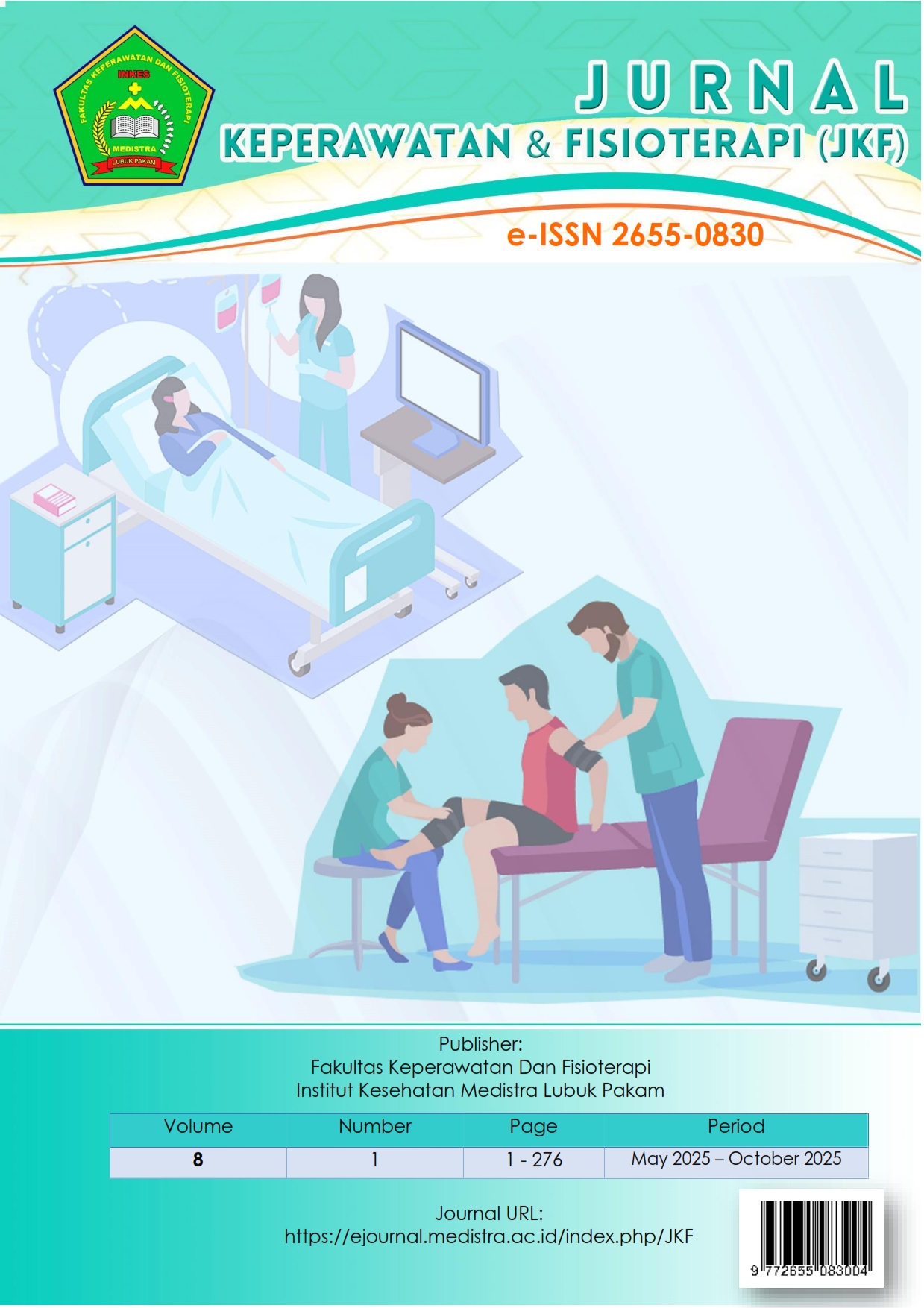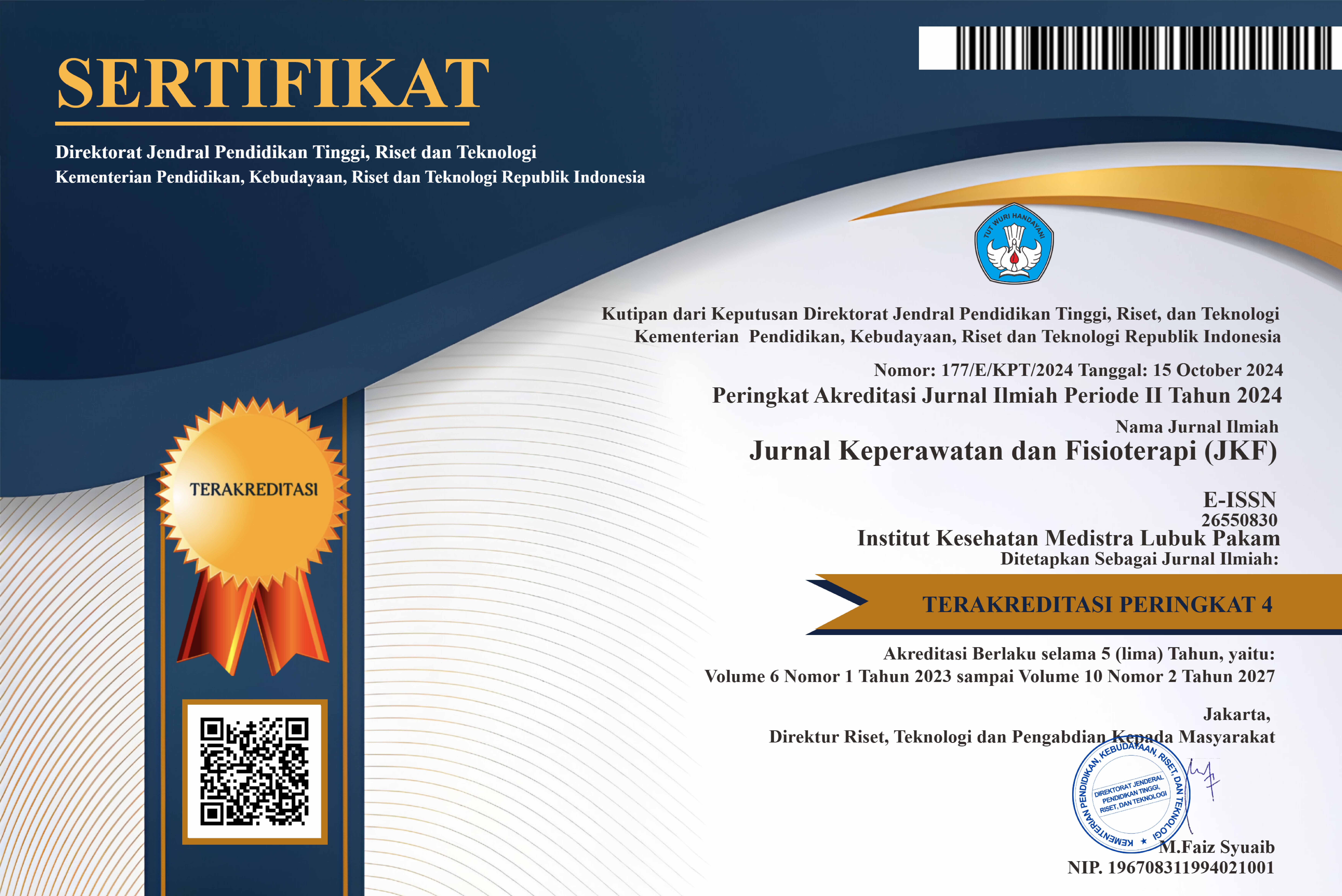The Relationship Between School Bag Load And The Degree Of Scoliosis Spinal Curve In Children Aged 8-12 Years
DOI:
https://doi.org/10.35451/ggrbex26Keywords:
Bag Load, Variable Relantionship, Spinal Curve, Scoliometer, Digital ScaleAbstract
Introduction: Carrying a bag that is too heavy, especially if it exceeds 10% of a child's body weight, is one of the risk factors that can cause postural disorders. This condition can have an impact on changes in the degree of spinal curvature, especially in the context of scoliosis. Objective: This study aims to examine the relationship between bag weight and the degree of scoliosis spinal curvature in children. Method: This study used a quantitative approach with a cross-sectional observational design. The determination of the number of samples was based on the Slovin formula. The design used was a one-group design with an additional analytical approach to evaluate the effects caused. Data were collected by measuring the weight of the bag using a digital scale and measuring the curvature of the spine using a scoliometer. Results: The results of the Kolmogorov-Smirnov test showed that the data did not follow a normal distribution. The Spearman correlation test indicated a relationship between bag weight and the degree of spinal curvature, although the relationship was weak. In addition, the Wilcoxon test showed a significant difference between the two measurement methods used. Conclusion: There is a significant relationship between bag weight and spinal curvature in children aged 8 to 12 years.
Downloads
References
[1] M. N. Bustan, I. Aprilo, and K. Anwar, “Derajat Kesehatan Jasmani dan Postur Siswa Sekolah di Makassar,” Media Kesehat. Masy. Indones., vol. 14, no. 1, p. 93, 2018, doi: 10.30597/mkmi.v14i1.3781.
[2] A. F. Naufal and N. I. Wahyuni.H, “Postur Abnormal dan Keseimbangan Pada Anak: Literature Study,” FISIO MU Physiother. Evidences, vol. 3, no. 2, pp. 113–119, 2022, doi: 10.23917/fisiomu.v3i2.18040.
[3] M. Fakultas, K. Universitas, and D. Dini, “Efektivitas Skoliometer Sebagai Alat Deteksi Dini Skoliosis,” pp. 58–61.
[4] L. S. Ani, “Deteksi dini skoliosis di tingkat Sekolah Dasar Katolik Santo Yoseph 2,” vol. 10, no. 2, pp. 253–257, 2019, doi: 10.15562/ism.v10i2.185.
[5] H. Winata, “Hipermobilitas Sendi pada Anak-Anak dengan Skoliosis Idiopatik Joint Hypermobility in Children with Idiopathic Scoliosis,” no. 6.
[6] J. Chowanska, T. Kotwicki, K. Rosadzinski, and Z. Sliwinski, “School screening for scoliosis: Can surface topography replace examination with scoliometer?,” Scoliosis, vol. 7, no. 1, pp. 1–7, 2012, doi: 10.1186/1748-7161-7-9.
[7] T. W. Mangkung, I. B. K. J. Sutawan, T. G. Senapathi, and I. M. Wiryana, “Monitoring neurofisiologis pada Adolescent Idiopathic Scoliosis yang menjalani operasi koreksi deformitas,” Medicina (B. Aires)., vol. 52, no. 1, p. 1, 2021, doi: 10.15562/medicina.v52i1.1029.
[8] Y. Febriani, “Edukasi Akan Dampak Penggunaan Tas Ransel Yang Salah,” Empower. Soc. J., vol. 2, no. 2, pp. 155–160, 2021, [Online]. Available: https://ojs.fdk.ac.id/index.php/ESJ/article/view/1477/pdf
[9] P. Oktari, N. U. Putri, S. Sintaro, M. Kom, and F. Trisnawati, “PENGEMBANGAN ALAT UKUR BATAS KAPASITAS TAS SEKOLAH ANAK BERBASIS MIKROKONTROLER,” vol. 1, no. 1, pp. 1–5, 2020.
[10] V. N. Mei and Z. Sugiyarti, “Hubungan Antara Beban Tas Terhadap Risiko Skoliosis Pada Anak Usia 9-12 Tahun di SDN Gonilan 02,” vol. 2, no. 3, 2024.
[11] M. S. Pratama, T. G. Amanda, H. Purnomo, and I. Yugantara, “Penyuluhan Potensi Skoliosis Untuk Mengatasi Perbaikan Postur Tubuh Pada Anak SD Negeri 1 Taruban,” vol. 2, no. 2, 2023.
[12] N. F. Amin, S. Garancang, K. Abunawas, M. Makassar, I. Negeri, and A. Makassar, “PENDAHULUAN Penelitian merupakan proses kreatif untuk mengungkapkan suatu gejala melalui cara tersendiri sehingga diperoleh suatu informasi . Pada dasarnya , informasi tersebut merupakan jawaban atas masalah-masalah yang dipertanyakan sebelumnya . Oleh ka,” vol. 14, no. 1, pp. 15–31, 2023.
[13] N. I. Majdina, B. Pratikno, and A. Tripena, “Penentuan Ukuran Sampel Menggunakan Rumus Bernoulli Dan Slovin: Konsep Dan Aplikasinya,” J. Ilm. Mat. dan Pendidik. Mat., vol. 16, no. 1, p. 73, 2024, doi: 10.20884/1.jmp.2024.16.1.11230.
[14] R. Pratama et al., “Correlational Research,” vol. 6, pp. 1754–1759, 2023.
[15] M. U. Smartphone, “Reliability and Validity of Angle of Trunk Rotation Measurement Using Smartphone and 3D Printing Technology in Scoliosis,” vol. 34, no. 6, pp. 283–291, 2022.
[16] J. Sarassanthi, I. G. A. Sena, N. Luh, M. Reny, and W. Sari, “Kekuatan Otot Dalam Pembebanan Punggung pada Anak Usia 10-12 Tahun di SD Negeri 1 Belantih , Bangli,” vol. 7, no. Desember, pp. 103–108, 2024.
[17] S. S. Ojha, “B URDEN O F T HE S CHOOL B AG : I S A NYBODY L ISTENING ?,” vol. 5, no. 1, pp. 87–100, 2015.
[18] A. Syahirah, . Muliani, and . Yuliana, “Nyeri Muskuloskeletal Pada Anak Sd Di Sd Kristen Harapan Usia 10 Hingga 12 Tahun Karena Tas Ransel Yang Berat : Studi Pilot,” E-Jurnal Med. Udayana, vol. 10, no. 5, p. 43, 2021, doi: 10.24843/mu.2021.v10.i5.p08.
[19] D. Andesta, “Perancangan Tas Sekolah Berbasis Model Ergonomic – Anthropometry Guna Pengembangan Sentra Industri Tas Di Kabupaten Gresik,” MATRIK (Jurnal Manaj. dan Tek., vol. 12, no. 2, p. 114, 2018, doi: 10.30587/matrik.v12i2.397.
[20] R. Head and P. Science, “r P Fo ee r R ev ie w On Fo r P iew On ly,” 2012.
[21] A. Syahri and H. Sutysna, Pinem, “Hubungan Penggunaan Tas Jenis Ransel dengan Kejadian Nyeri Punggung Bawah pada Siswa Kelas V Sekolah Dasar Muhammadiyah 08 Medan Tahun 2016,” Anat. Med. J., vol. 1, no. 1, pp. 21–26, 2018.
[22] S. Sangam, A. Naveed, M. Athar, P. Prathyusha, S. Moulika, and S. Lakshmi, “International Journal of Health Sciences and Research,” vol. 5, no. 1, pp. 156–164, 2015.
[23] Kementerian Kesehatan Republik Indonesia, “Peraturan Menteri Kesehatan Republik Indonesia Nomor 65 Tahun 2015 Tentang Standar Pelayanan Fisioterapi,” Kementeri. Kesehat. Republik Indones., vol. 16, no. 2, pp. 39–55, 2015.
[24] D. A. Nawir, W. Ode, N. Isnah, and K. T. Handayani, “Skrining Gangguan Postur Tubuh dan Edukasi Postur Tubuh yang Ideal pada Siswa SD Inpres Bung Tahun 2024,” vol. 7, no. 1, pp. 113–120, 2025, doi: 10.36565/jak.v7i1.891.
[25] S. Tuhuteru et al., “J . A . I : Jurnal Abdimas Indonesia,” Abdimas Indones., vol. 1, no. 2, pp. 26–32, 2021, [Online]. Available: https://dmi-journals.org/jai/article/view/226
Downloads
Published
Issue
Section
License
Copyright (c) 2025 Reza Ghani Abdul Azis, Adnan Faris naufal

This work is licensed under a Creative Commons Attribution 4.0 International License.
Copyright in each article is the property of the Author.


























